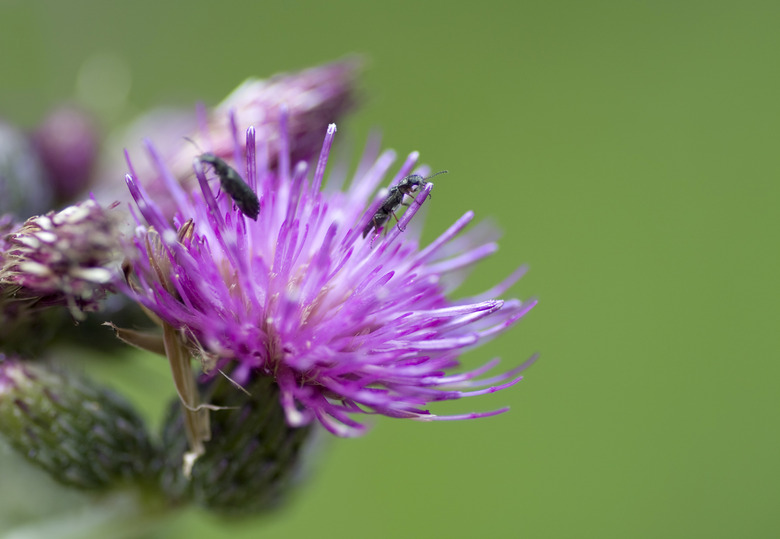Kinds Of Seed Plants
Seed-bearing plants are also called spermatophytes, and they all belong to the plant kingdom. A subset of land plants, spermatophytes comprise about 96 percent of living land plants, according to BioNumbers. There are about 850 species of gymnosperms and more than 350,000 species of angiosperms living on the planet today.
Two kinds of plants bear seeds: gymnosperms and angiosperms. Gymnosperm means "naked seed," and refers to the fact that these seed-bearing plants do not produce fruit to protect their seeds. In contrast, the angiosperms – otherwise known as the "flowering plants" – form flowers that become fruit. Although gymnosperms and angiosperms produce different types of seeds, there are some similarities between these two kinds of plants.
Characteristics of Seed Plants
Characteristics of Seed Plants
According to Biology(OpenStax'>Biology LibreTexts/5%3A_Biological_Diversity/26%3A_Seed_Plants/26.1%3A_Evolution_of_Seed_Plants), seed plants first grew on Earth about one million years ago. Descendants of ferns and mosses, as spermatophytes evolved, they developed structures to protect their embryos and wait for favorable conditions to grow. While spores are the reproductive structures of ferns and mosses, spermatophytes encase their offspring in structures known as seeds.
This evolutionary adaptation allows the seed plants to survive drought, as seeds can remain dormant in the soil for many years, waiting for the right conditions to germinate. Spermatophytes are a widely diverse group of plants, ranging from tiny angiosperms like duckweed to towering gymnosperms like sequoias.
The production of seeds also allows gymnosperms to package food along with their plant embryo, supplying a young seedling with the nutrients it needs to sprout and establish by growing roots and shoots. Because seed plants package food supplies with their embryos, spermatophytes are commonly grown as food sources for humans, too. Common crops like corn, wheat, rice and many fruits and vegetables are produced by seed plants.
Kinds of Gymnosperms
Kinds of Gymnosperms
Cycads – which are palm-like trees – along with conifer and ginkgo trees are different kinds of plants that belong to the "naked seed" group, also known as gymnosperms. This group of seed-bearing plants does not flower; instead, many of them encase their seeds in cones, notes Jove.
Pine trees and evergreens are familiar examples of conifers. With needle-like leaves that stay green all year, specific types of these cone-bearing gymnosperms include cedar, Douglas fir, cypress, fir, juniper, hemlock, redwood, spruce and yew.
Producing structures similar to cones, cycads often look like palm trees – but palms are angiosperms, while cycads are gymnosperms. Many of the cycads are extinct, and the few species that still live on the planet are found mostly in tropical and subtropical regions.
The third group of gymnosperms is made up of one genus, Ginkgo. There is one one living example of this genus, which is Gingko biloba. Native to China, the gingko tree produces fanlike leaves with two lobes, which explains the Latin name of this species.
Examples of Angiosperms
Examples of Angiosperms
There are over 400 families of angiosperms, the most diverse group of land plants. Different kinds of plants in this large group of seed plants include many of the species we cultivate for food and ornamental value. Fruit trees like cherries, apples, pears and peaches are angiosperms. Flowering shrubs such as azalea and rhododendron are angiosperms. Vegetables, seeds and grains like broccoli, carrots, peas, sunflower seeds and oats also belong to this group.
Angiosperms and gymnosperms both make types of seeds, but angiosperms also produce flowers and fruit. Flowers are the reproductive structures of angiosperms, and fruits help protect the plant embryos of flowering plants.
There are two types of angiosperms: monocots and dicots. Grasses are monocots, which usually produce one cotyledon, or seed leaf, notes Saint Xavier University. Dicots, with seeds that contain two cotyledons, include familiar species like beans, strawberries, tomatoes, peppers, watermelons, and many of the trees and ornamental plants grown in gardens and parks.
Cite This Article
MLA
Sloane, Christina. "Kinds Of Seed Plants" sciencing.com, https://www.sciencing.com/kinds-of-seed-plants-13404717/. 30 September 2021.
APA
Sloane, Christina. (2021, September 30). Kinds Of Seed Plants. sciencing.com. Retrieved from https://www.sciencing.com/kinds-of-seed-plants-13404717/
Chicago
Sloane, Christina. Kinds Of Seed Plants last modified March 24, 2022. https://www.sciencing.com/kinds-of-seed-plants-13404717/
